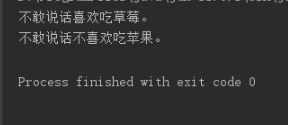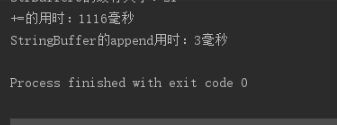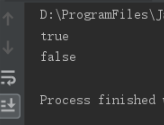Java内存分配--堆、栈、常量池
Java内存分配主要包括以下几个区域:
1. 寄存器:我们在程序中无法控制
2. 栈:存放基本类型的数据和对象的引用,但对象本身不存放在栈中,而是存放在堆中
3. 堆:存放用new产生的数据
4. 静态域:存放在对象中用static定义的静态成员
5. 常量池:存放常量
6. 非RAM(随机存取存储器)存储:硬盘等永久存储空间
字符串常量池--引入
public class test2 {
public static void main(String[] args){
String name1="不敢说话";
String name2="不敢说话";
System.out.println(name1==name2);
}
}
String对象是不可变的,字符串一旦创建,内容就不能该变。
Java中为了效率考虑,以" "包括的字符串只要内容相同,无论在程序代码中出现过几次JVM都只会建立一个实例,放在字符串池中维护。
字符串拼接--原理
public class test2 {
public static void main(String[] args){
String str="不敢说话";
str+="喜欢吃草莓。";
System.out.println(str);
String str2="不敢说话";
str2=str2.concat("不喜欢吃苹果。");
System.out.println(str2);
}
}
事实上+=和concat是等价的。我们先来看一下concat的原理代码

忽略中间的过程,总之,返回的是一个新创建的对象,所以每次写+=或者调用concat方法都会创建一个新的对象。
所以,这种写法与“字符串一旦创建,内容就不能该变。”这句话并不矛盾。
注意:调用concat的方法时写str=str.concat("喜欢吃草莓"),不能写成str.concat("喜欢吃草莓")。如果用第二种写法,只时在JVM中创建了一个新的对象而已,str这个引用变量中存的地址还是“不敢说话”的地址,输出的时候不会是拼接的结果。
String与StringBuffer
StringBuffer引入
public class StringBufferDemo {//StringBuffer是+=的大概1000倍!!!
public static void main(String[] args){
final int N=100000;
//使用String进行字符串拼接
long starTime=System.currentTimeMillis();
String str="*";
for(int i=0;i<N;i++){
str+="*";
}
long endTime=System.currentTimeMillis();
System.out.println("+=的用时:"+(endTime-starTime)+"毫秒");
//使用StringBuffer进行字符串拼接
starTime=System.currentTimeMillis();
StringBuffer str0=new StringBuffer("*");
for(int i=0;i<N;i++){
str0.append("*");
}
endTime=System.currentTimeMillis();
System.out.println("StringBuffer的append用时:"+(endTime-starTime)+"毫秒");
//还有StringBuilder
}
}

为什么要使用StringBuffer?
我们看见,用String去实现字符串拼接,消耗的时间竟然是StringBuffer的很多倍。怎么会这样呢?
以下这段话摘自于https://blog.csdn.net/fengshizty/article/details/41482793

String中的equals和StringBuffer中的equals
public class equalsDemo {
public static void main(String[] args){
String value="helloworld";
value+="Good";
String value2="helloworldGood";
//System.out.println(value==value2);
System.out.println(value.equals(value2));
StringBuffer strBuffer3=new StringBuffer("你好成都!");
StringBuffer strBuffer4=new StringBuffer("你好成都!");
System.out.println(strBuffer3.equals(strBuffer4));
//System.out.println(strBuffer3.toString().equals(stringBuffer4.toString()));//全用toStirng()转成字符串比较的就是值而已
}
}

看到这里也许就疑惑了,诶?怎么同时equals,要比较的字符串也一样啊,怎么输出第一个就是true第二个就是false呢?
String类中的equals方法是对父类Object类中的equals方法的覆盖,比较的是字符串的内容是否相同。
而StringBuffer类中的equals方法没有覆盖Object的方法,比较的是两个字符串的地址。
这就不难理解为什么第一个输出true第二个输出false了。
关于 "=="
public class test2 {
public static void main(String[] args){
int a=1;
double b=1;
System.out.println(a==b);
String str1="不敢说话";
String str2="不敢说话";
System.out.println(str1==str2);
String str3=new String("不敢说话");
String str4=new String("不敢说话");
System.out.println(str3==str4);
}
}
当==比较的是两个基本数据类型的变量是,比较的是二者的值。
而==比较的是两个引用类型的引用变量是,比较的是二者的地址。